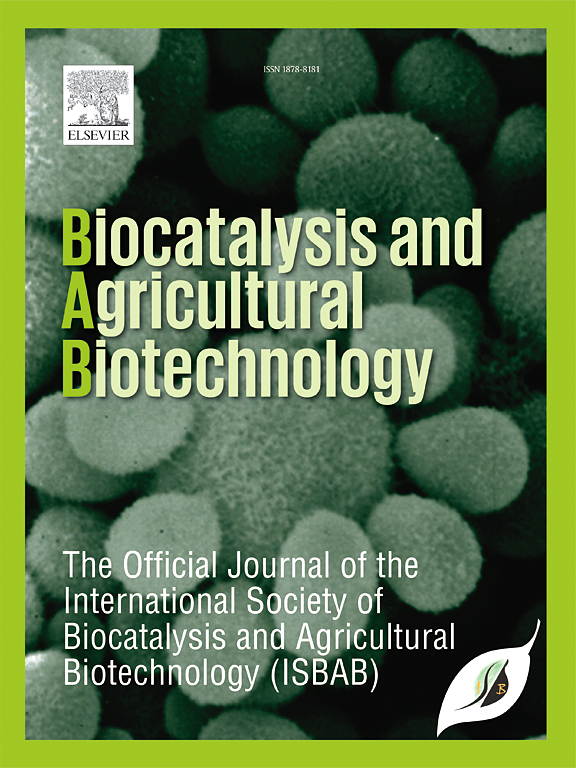Overexpression of Gossypium arboreum 3-ketoacyl-CoA synthase 6 (GaKCS6) gene enhanced leaf epicuticle wax in Gossypium hirsutum L. and improved tolerance against whitefly
IF 3.4
Q2 BIOTECHNOLOGY & APPLIED MICROBIOLOGY
引用次数: 0
Abstract
Cotton Leaf Curl Virus (CLCuV) is a significant threat to cotton production, as it causes Cotton Leaf Curl Disease (CLCuD). Whitefly serves as a vector for the transmission of this virus. It can be controlled by developing barriers against whitefly infestation. The leaf epicuticle wax acts as a protective barrier against whitefly attacks. Research into wax biosynthesis and the fatty acid elongation pathway has highlighted the role of the 3-ketoacyl-CoA synthase (KCS) gene family in producing very-long-chain fatty acids (VLCFAs) in plants. The 3-ketoacyl-CoA synthase 6 (GaKCS6) gene, isolated from the CLCuV-resistant FDH-170 variety of Gossypium arboreum, was cloned under the control of the CaMV35S constitutive promoter and transformed into the CLCuV-susceptible Gossypium hirsutum variety CKC-3 resulting in significantly higher leaf epicuticle wax deposition. Overexpression of GaKCS6 in the transgenic cotton plants was confirmed through quantitative real-time PCR. The transgenic plants not only exhibited average growth but also showed improvements in agronomic traits. Scanning Electron Microscope (SEM) analysis further validated the enhanced leaf epicuticle wax deposition in transgenic plants compared to non-transgenic (control). A free-choice bioassay against whiteflies demonstrated that the transgenic plants remained free of viral infection, as confirmed by real-time PCR. These findings indicate that increased leaf epicuticle wax deposition in transgenic cotton effectively prevents whitefly attacks and the transmission of CLCuV. It suggests that the GaKCS6 gene plays a crucial role in producing leaf epicuticle wax through the VLCFAs biosynthesis pathway.
过表达 3-Ketoacyl-CoA 合成酶 6 (GaKCS6) 基因可增强 Gossypium hirsutum L. 的叶表皮蜡质并提高其对粉虱的耐受性
棉花卷叶病毒(CLCuV)是棉花生产的一个重大威胁,因为它会导致棉花卷叶病(CLCuD)。粉虱是这种病毒的传播媒介。可以通过开发防止粉虱侵扰的屏障来控制这种病毒。叶片表皮蜡是防止粉虱侵袭的保护屏障。对蜡的生物合成和脂肪酸伸长途径的研究强调了 3-酮酰基-CoA合成酶(KCS)基因家族在植物中产生超长链脂肪酸(VLCFA)方面的作用。在 CaMV35S 组成型启动子的控制下克隆了从抗 CLCuV 的格桑花品种 FDH-170 中分离出的 3-Ketoacyl-CoA 合成酶 6(GaKCS6)基因,并将其转化到易受 CLCuV 影响的格桑花品种 CKC-3 中,结果显著提高了叶片表皮蜡的沉积量。通过实时定量 PCR,证实了 GaKCS6 在转基因棉花植株中的过表达。转基因植株不仅长势良好,而且农艺性状也有所改善。扫描电子显微镜(SEM)分析进一步证实,与非转基因植株(对照)相比,转基因植株叶片表皮蜡沉积增强。针对粉虱的自由选择生物测定表明,转基因植物仍未受到病毒感染,这一点也得到了实时 PCR 的证实。这些研究结果表明,转基因棉花叶片表皮蜡沉积的增加能有效防止粉虱的侵袭和 CLCuV 的传播。这表明 GaKCS6 基因在通过 VLCFAs 生物合成途径产生叶片表皮蜡质方面发挥了关键作用。
本文章由计算机程序翻译,如有差异,请以英文原文为准。
求助全文
约1分钟内获得全文
求助全文
来源期刊

Biocatalysis and agricultural biotechnology
Agricultural and Biological Sciences-Agronomy and Crop Science
CiteScore
7.70
自引率
2.50%
发文量
308
审稿时长
48 days
期刊介绍:
Biocatalysis and Agricultural Biotechnology is the official journal of the International Society of Biocatalysis and Agricultural Biotechnology (ISBAB). The journal publishes high quality articles especially in the science and technology of biocatalysis, bioprocesses, agricultural biotechnology, biomedical biotechnology, and, if appropriate, from other related areas of biotechnology. The journal will publish peer-reviewed basic and applied research papers, authoritative reviews, and feature articles. The scope of the journal encompasses the research, industrial, and commercial aspects of biotechnology, including the areas of: biocatalysis; bioprocesses; food and agriculture; genetic engineering; molecular biology; healthcare and pharmaceuticals; biofuels; genomics; nanotechnology; environment and biodiversity; and bioremediation.
 求助内容:
求助内容: 应助结果提醒方式:
应助结果提醒方式:


